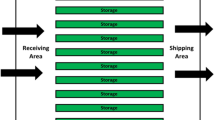Abstract
This paper investigates the gap between qualitative and quantitative constraints in spare parts stock control, with specific reference to warship spare parts support projects. A critical literature review of theoretical contributions about qualitative or quantitative factors for warship spare parts warehouse management is firstly provided, which allows to analyze the reasons for this qualitative-quantitative gap by addressing the limitations of spare parts models developed in the literature. Therefore a model including cloud model, marginal analysis and Lagrange multiplier method (CML) for study is proposed in this paper to bridge the gap. The model is used to solve the mix-constraints (both qualitative and quantitative constraints are considered) problem in a logic decision diagram particularly at the different decision nodes of the diagram. Finally, verifying test results show that the algorithm is feasible and its optimal support project meets the needs of engineering practices.
Similar content being viewed by others
References
SLEPTCHENKO A, VAN DER HEIJDEN M C, VAN HARTEN A. Effects of finite repair capacity in multiechelon, multi-indenture service part supply systems [J]. International Journal of Production Economics, 2002, 79(3): 209–230.
RUSTENBURG W D, VAN HOUTUM G J, ZIJM W H M. Spare parts management at complex technologybased organizations: An agenda for research [J]. International Journal of Production Economics, 2001, 71(1): 177–193.
SHERBROOKE C C. Metric: A multi-echelon tech nique for recoverable item control [J]. Operations Research, 1968, 16(1): 122–141.
WEI S H, CHEN Y Q, JIN J S. Warship spare parts allotment method under space and cost constraints [J]. Systems Engineering and Electronics, 2013, 35(12): 2540–2544 (in Chinese).
CAI Z M, JIN J S, CHEN Y Q, et al. Warship spare parts allotment method under multi-constraints [J]. Systems Engineering and Electronics, 2015, 37(4): 838–844 (in Chinese).
LIU Y, GAI Q, ZHAO C, et al. Research on spare parts storage decision for ships on sailing in multi-restrain [J]. Ship Science and Technology, 2013, 35(11): 144–147 (in Chinese).
LEE L H, CHEW E P, TENG S, et al. Multi-objective simulation-based evolutionary algorithm for an aircraft spare parts allocation problem [J]. European Journal of Operational Research, 2008, 89(2): 476–491.
KLINE R C, BACHMAN T C. Estimating spare parts requirements with commonality and redundancy [J]. Journal of Spacecraft and Rockets, 2007, 44(4): 977–984.
RUAN M Z, LI Q M, ZHANG G Y, et al. Optimization method of carrying spare parts warship equipment under multi-constraints [J]. Acta Armamentarii, 2013, 34(9): 1144–1149 (in Chinese).
WANG N C, KANG R. An optimization model for inventory spares under multi-constraints and its decomposition algorithm [J]. Acta Armamentarii, 2009, 30(2): 247–251 (in Chinese).
FEI G Y, ZHANG Z H, LIU J, et al. Configuration method of spares on warship [J]. Command Control & Simulation, 2014, 36(3): 133–136 (in Chinese).
BIAN J H, GUO L H, KANG R, et al. Spares optimization under the influence of false alarm [J]. Journal of Beijing University of Aeronautics and Astronautics, 2014, 40(3): 413–416 (in Chinese).
WANG Z Y, CAO J P, ZHU Y H, et al. Optimization model on removable spare parts warehouse deployment [J]. Systems Engineering and Electronics, 2013, 35(11): 2352–2355 (in Chinese).
XU L, LI Q M, RUAN M Z. Support project optimization for warship formation with finite repair capacity [J]. Systems Engineering and Electronics, 2014, 36(11): 2226–2232 (in Chinese).
WANG Z Y, CAO J P, ZHU Y, et al. An optimization model of wartime spare parts resource allocation on consideration of maintainability [J]. Acta Armamentarii, 2014, 35(5): 719–724 (in Chinese).
ROOSTAEE R. A multi-criteria intuitionistic fuzzy group decision making method for supplier selection with VIKOR method [J]. International Journal of Fuzzy System Applications (IJFSA), 2012, 2(1): 1–17.
HUANG H Z, LIU Y, LI Y F, et al. New evaluation methods for conceptual design selection using computational intelligence techniques [J]. Journal of Mechanical Science and Technology, 2013, 27(3): 733–746.
LI D Y, MENG H J, SHI X M. Membership clouds and membership cloud generators [J]. Journal of Computer Research and Development, 1995, 32(6): 15–20 (in Chinese).
FARLEY R D, PHUONG N, HAROLD D O. Numerical simulation of cloud seeding using a threedimensional cloud model [J]. The Journal of Weather Modification, 2014, 26(1): 113–124.
REZAEI R, CHIEW T K, LEE S P, et al. Interoperability evaluation models: A systematic review [J]. Computers in Industry, 2014, 65(1): 1–23.
MOLENAERS A, BAETS H, PINTELON L, et al. Criticality classification of spare parts: A case study [J]. International Journal of Production Economics, 2012, 140(2): 570–578.
ROMEIJNDERS W, TEUNTER R, VAN JAARSVELD W. A two-step method for forecasting spare parts demand using information on component repairs [J]. European Journal of Operational Research, 2012, 220(2): 386–393.
COSTANTINO F, GRNVIO G D, TRONCI M. Multiechelon, multi-indenture spare parts inventory control subject to system availability and budget constraints [J]. Reliability Engineering & System Safety, 2013, 119: 95–101.
ZHANG F, YIN X Q. The standard time measurement based on product batch production [J]. Journal of Shandong University of Technology (Natural Science Edition), 2014, 28(3): 56–59 (in Chinese).
LI D Y, LIU C Y. Study on the universality of the normal cloud model [J]. China Engineering Science, 2004, 6(8): 28–34 (in Chinese).
Author information
Authors and Affiliations
Corresponding author
Additional information
Foundation item: the National Defence Researching Fund (No. 51319060103)
Rights and permissions
About this article
Cite this article
Jin, J., Cai, Z. & Chen, Y. Warship spare parts configuration optimization for stock control: Investigating the gap between qualitative and quantitative constraints. J. Shanghai Jiaotong Univ. (Sci.) 22, 440–448 (2017). https://doi.org/10.1007/s12204-017-1858-9
Received:
Published:
Issue Date:
DOI: https://doi.org/10.1007/s12204-017-1858-9




